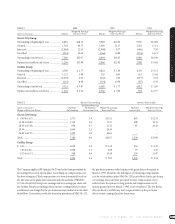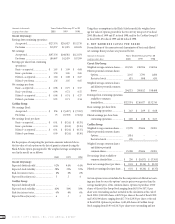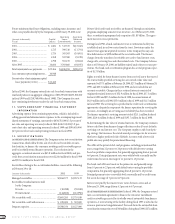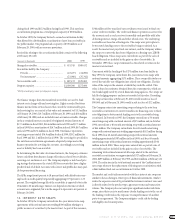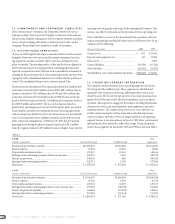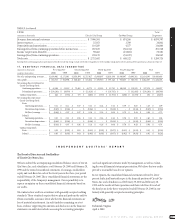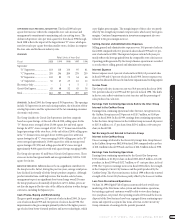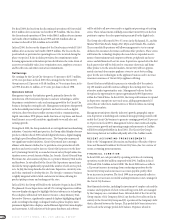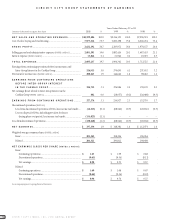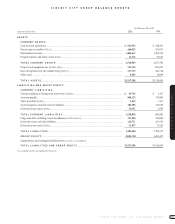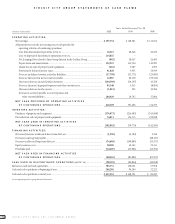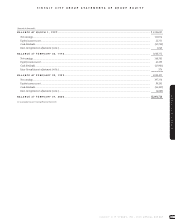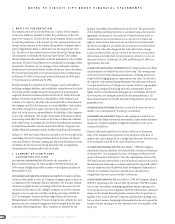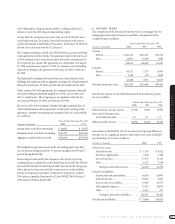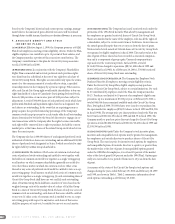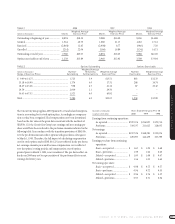CarMax 2000 Annual Report Download - page 51
Download and view the complete annual report
Please find page 51 of the 2000 CarMax annual report below. You can navigate through the pages in the report by either clicking on the pages listed below, or by using the keyword search tool below to find specific information within the annual report.
CIRCUIT CITY STORES, INC. 2000 ANNUAL REPORT 49
CIRCUIT CITY GROUP
increases in pooled debt are reflected in the weighted average interest rate
of the pooled debt.
In addition to the allocation of cash and debt,interest-bearing loans, with
terms determined by the board of directors,are used to manage cash
between the Groups. These loans are reflected as inter-group payables or
receivables on the financial statements of each Group. During fiscal 1998,
an inter-group note was issued by the Circuit City Group on behalf of the
CarMax Group as a temporary financing vehicle for CarMax inventory. At
the end of fiscal 2000 and fiscal 1999, the Circuit City Group maintained
no inter-group notes,payables or receivables with the CarMax Group.
During fiscal 2000, a term loan totaling $175 million and due in May 2000
was classified as a current liability. Although the Company has the ability
to refinance this loan,it intends to repay the debt using existing working
capital. Payment of corporate debt will not necessarily reduce Circuit City
Group allocated debt.
The Circuit City Group’s capital expenditures were $176.9 million in fiscal
2000,$214.1 million in fiscal 1999 and $341.6 million in fiscal 1998. Circuit
City’s capital expenditures through fiscal 2000 primarily were related to
Superstore expansion. Capital expenditures for the Circuit City Group
have been funded through sale-leaseback transactions,landlord reim-
bursements and allocated short- and long-term debt. In fiscal 2001, the
Group anticipates capital expenditures of approximately $245 million,
primarily related to construction of new Superstores and the remodeling
of 30 to 35 existing Superstores. Sale-leaseback and landlord reimburse-
ment transactions totaled $74.8 million in fiscal 2000,$134.3 million in
fiscal 1999 and $199.0 million in fiscal 1998.
The Group’s finance operation primarily funds its credit card programs
through securitization transactions that allow the operation to sell its
receivables while retaining a small interest in them. The finance opera-
tion has a master trust securitization facility for its private-label credit
card that allows the transfer of up to $1.85 billion in receivables through
both private placement and the public market. A second master trust
securitization program allows for the transfer of up to $1.75 billion in
receivables related to the operation’s bank card programs. Securitized
receivables totaled $2.79 billion at February 29, 2000. Under the securiti-
zation programs,receivables are sold to an unaffiliated third party with
the servicing rights retained. Management expects that both securitiza-
tion programs can be expanded to accommodate future receivables growth.
At the end of fiscal 2000,the Circuit City Group retained a 74.7 percent
interest in the equity of the CarMax Group. As of February 29, 2000, the
Circuit City Group’s equity in the CarMax Group was $257.5 million.
Management believes that proceeds from sales of property and equip-
ment and receivables,future increases in Circuit City Stores, Inc. debt
allocated to the Circuit City Group and cash generated by operations will
be sufficient to fund the capital expenditures and operations of the Circuit
City business.
MARKET RISK
The Company manages the private-label and bank card revolving loan
portfolios of the Group’s finance operation. Portions of these portfolios
are securitized and,therefore,are not presented on the Group’s balance
sheets. Interest rate exposure relating to these receivables represents a
market risk exposure that the Company has managed with matched fund-
ing and interest rate swaps.
Interest rates charged on the accounts in the managed private-label and
bank card portfolios are primarily indexed to the prime rate,adjustable
on a monthly basis,with the balance at a fixed annual percentage rate.
Total principal outstanding at February 29, 2000, and February 28, 1999,
had the following APR structure:
(Amounts in millions) 2000 1999
Indexed to prime rate............................................. $2,631 $2,714
Fixed APR............................................................... 213 243
Total ....................................................................... $2,844 $2,957
Financing for the securitization programs is achieved primarily through
the issuance of public market debt,which is issued either at floating rates
based on LIBOR or at fixed rates. Certain of the fixed-rate issuances have
been swapped to LIBOR. Receivables held by the Company for investment
or sale are financed with working capital. At February 29, 2000, and
February 28, 1999, financings were as follows:
(Amounts in millions) 2000 1999
Floating-rate (including synthetic
alteration) securitizations................................ $2,544 $2,568
Fixed-rate securitizations ...................................... 137 187
Held by the Company:
For investment ................................................. 145 162
For sale............................................................. 18 40
Total ....................................................................... $2,844 $2,957
The Company has analyzed its interest rate exposure and has concluded
that it did not represent a material market risk at February 29, 2000, or
February 28, 1999. Because programs are in place to manage interest rate
exposure relating to the consumer loan portfolios,the Company expects
to experience relatively little impact if interest rates fluctuate. The Com-
pany also has the ability to adjust fixed-APR revolving cards and the
index on floating-rate cards, subject to cardholder ratification,but does
not currently anticipate the need to do so.
YEAR 2000 CONVERSION
Refer to the “Management’s Discussion and Analysis of Results of Opera-
tions and Financial Condition”for Circuit City Stores, Inc.for a discussion
of the Year 2000 issue and its impact on the Group’s financial statements.
FORWARD-LOOKING STATEMENTS
Company statements that are not historical facts, including statements
about management’s expectations for fiscal year 2001 and beyond,are
forward-looking statements and involve various risks and uncertainties.
Refer to the “Circuit City Stores, Inc. Management’s Discussion and Anal-
ysis of Results of Operations and Financial Condition”for a review of pos-
sible risks and uncertainties.


